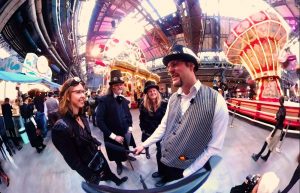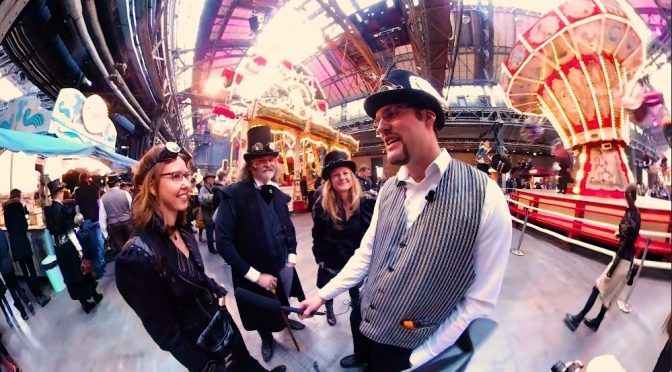This is a systematic introduction to 360° video and photography production methods for journalism (mostly news coverage): Overview and theoretical considerations by Kai Rüsberg for scientific and educational use as a topic collection. tbc

Fundamentals for 360° video and photo
- What is 360°, what is VR, what is Augmented Reality?
- How are media produced for virtual realities? Which formats do exist?
- How can virtual media be presented? Which internet platforms, software and hardware are there for presenting?
- Marketplaces and distribution channels for virtual stories and software on the internet.
- Who are the users? What are their needs or interests?
Journalism with all perspectives
- Journalism in virtual reality: Which report forms? Where is the journalism in 360°?
- Which subjects are suited. Which are unacceptable?
- The role of the journalist: Should the reporter appear in the picture of 360° reports? Or shoot, run and hide – be hidden on the recording?
- Does it generally need explanations if the spectator can look around by himself?
Production of 360° media
- Which hardware for the production of 360°: Market overview of typical cameras incl. assessment.
- The resolutions and picture variations: QHD, 4K, 8K, full dome or 180/360?
- Settings in the camera and practise with admissions with 360° cameras.
- Before the trick: Installation, tripods, nadir, movement of the camera.
- Ideal conditions for the installation in the space, audio admission and exposure.
Directing a 360° production
- Is the director or author in the picture and can directly intervene?
- If director is out of sight of the camera, how can he direct?
- Usage of wireless communication and picture monitoring of the 360-device.
- Installation of additional monitoring and communication systems.
- Need a storyboard for 360 news production?
Language of VR*
- Close-ups, pans or zooms focus the viewer’s attention
- Proximity as a factor: What is closer to the camera seems to be more important
- Centering is directing the viewer’s attention.
- First shot of a VR film is the most important.
- First shot is the only time you have complete control over where the viewer will look first.
Audio in all dimensions
- The good tone: How is the audio captured? Where do I hide the microphones? Direct input or synchronisation in post processing?
- Multichannel audio, Ambisonics, 3D-audio and Spatial audio: The high school of the locatable audio admission.
- Which technology is available for multichannel-audio admission?
- The sound, which comes from all sides, caught spherically: How do I make it right? Where do I place the microphones? What must I follow for post-processing?
- Which software and plug-ins to integrate my 3D-audio into the film project?
Lighting and external devices
- How to use natural and artificial light?
- Where to place artifical light? May the lights be visible?
- Unvisible artifical lights: Monopod-mounted systems.
- Using mono-/tripod oder gimbals for 360 cameras: market overview.
With both eyes: stereoscopic
- The entrance in real virtual reality: producing stereoscopic 360° videos and photos.
- Do-it-yourself construction or ready made models: What does the market offer with stereoscopy?
- Workflow with the post-processing: Which tools and software?
Treatment of the media
- Stitching: what does it mean and how do I make this? Which software?
- Cutting and storytelling in the timeline: Which software is available?
Possibilities of the post-processing and picture improvement with software and plug-ins. - The possibilities of insertions: Title, 2D video and text boards. What and how much makes sense?
- Correction and editing of stiching lines
- Cloning out tripods and other objects
Legal and ethics
- Who needs to be informed and how that 360 filming is in place?
-
Does the filming infringe the intellectual property rights of third parties (copyright, right of depiction, private life or harm the image of persons who may be identified within the content)
- What about children or other immature and the right of their their own likeness. Do you need a written consent of their caretakers? Are they in prominent position or in the background?
- Does the filming take place in a gated/closed-off area?
- Are you humiliating people in private surrounding or filming children (partly) nacked? (Maybe in a private room or Kindergarden, which could result in a criminal offence in Germany)
- Are you able to monitor the whole scene, esp. if streamed live?
- Inserting greenscreened shots into another picture or stiching of separatly shot parts of the sphere: is it cheating the viewer?
In addition… (to be defined later on)
- On-line platforms for the treatment and help / know how, education.
- Use of the material in other media like 2D video, fish-eye or little planet photography.
- Live transmission in 360°
- Continous exposure series of photos instead of video for resolution enhancements
Anything to criticise?
Anything to add?
Please put it in the comments below!
*= “Language of VR” after Dane Christensen in Medium “What I learned making a 360° video…”

